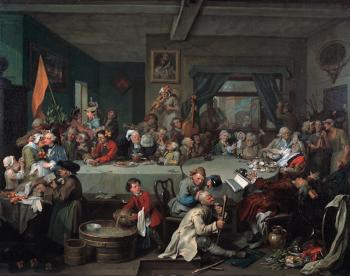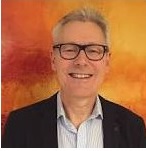
The Humours of an Election is a set of four oil paintings and engravings by William Hogarth. These were prompted by an election in Oxfordshire in 1754, the first there in over 20 years. The series was created in 1755-6. The first, an Election Entertainment, shows a meeting of the Whig party organising canvassing, with the Tory party shown in the background outside. This was at a time before the Great Reform Act, of no secret ballots and much bribery and intimidation of the small (male and property-owning) electorate. The painting showed the candidates, the mayor (in a state of inebriation) and many other figures, with bricks being thrown and other intimidation. The second painting, Canvassing for Votes, shows the rival parties gathering outside neighbouring pubs, with bribery of the electorate and many shenanigans. The third, The Polling, shows the actual election, with further bribery, and even a dead body being carried up to vote. The fourth, Chairing the Member, shows the aftermath, as a mock triumph of a Roman general, with one of the new members being carried through the town but on the verge of being toppled from his chair.
Ian Hislop, the editor of Private Eye, said that each painting had one big joke and many small jokes. Our expert speaker, Rupert Dickens, showed us both the overall pictures but also many of the details that compose the small jokes, and also the many visual references to earlier religious and other painting. The paintings were also reproduced as print series, and he pointed out many of the small detail differences between the paintings and the prints. He then brought us up to date with the influence of Hogarth on more recent political humour, contrasting the paintings to the more caricatured representations of Gilray and others right up to illustrations in cartoons this year that quote from Hogarth’s visual language.
Rupert Dickens is an art historian based in south London. He originally read PPE in Oxford and had a 26-year career in the BBC. He then retrained in art history at Birkbeck College before undertaking a Masters in Dutch Golden Age Studies at University College London. He now lectures at the Wallace Collection. He greatly entertained and informed the TASH members with a witty, erudite and thoughtful lecture.
Professor Robert Gurney
~~~~~~~~~~~~~~~~~~~~~~~~~~~~~~~~~~~~~~~~~~~~~~~~~~~~~~~~~~~~~~~~~~~~~


